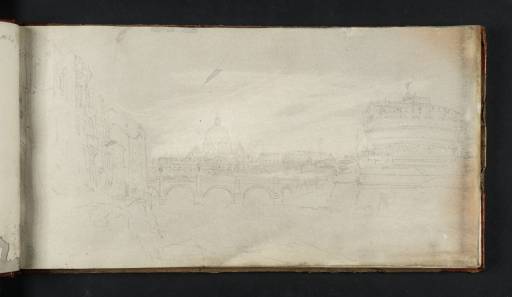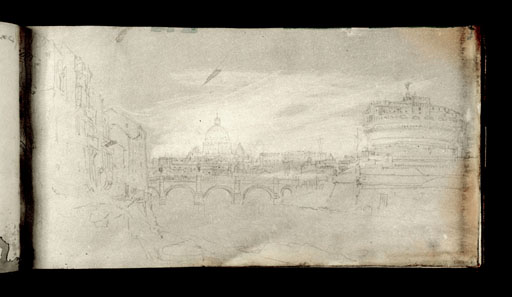Joseph Mallord William Turner St Peter's and the Castel Sant'Angelo, Rome 1819
Image 1 of 2
Joseph Mallord William Turner,
St Peter's and the Castel Sant'Angelo, Rome
1819
Joseph Mallord William Turner 1775–1851
Folio 9 Recto:
St Peter’s and the Castel Sant’Angelo, Rome 1819
D16405
Turner Bequest CXC 9
Turner Bequest CXC 9
Pencil and grey watercolour wash with traces of blue watercolour on white wove paper, 130 x 255 mm
Inscribed by ?John Ruskin in red ink ‘9’ top right
Stamped in black ‘CXC 9’ bottom right
Stamped in black ‘CXC 9’ bottom right
Accepted by the nation as part of the Turner Bequest 1856
References
1909
A.J. Finberg, A Complete Inventory of the Drawings of the Turner Bequest, London 1909, vol.I, p.565, as ‘Bridge and Castle of S. Angelo.’.
1914
Thomas Ashby, ‘Turner in Rome – II’, Burlington Magazine, vol.25, no.134, May 1914, p.103, reproduced Pl.I, A, as ‘The Castle and Bridge of S. Angelo, with St Peter’s in the Distance’.
1983
Cecilia Powell, ‘Turner’s Vignettes and the Making of Rogers’ “Italy” ’, Turner Studies, vol.3, no.1, Summer 1983, p.7.
1984
Cecilia Powell, ‘Turner on Classic Ground: His Visits to Central and Southern Italy and Related Paintings and Drawings’, unpublished Ph.D thesis, Courtauld Institute of Art, University of London 1984, p.285 note 71.
1987
Cecilia Powell, Turner in the South: Rome, Naples, Florence, New Haven and London 1987, p.[135] note 11.
The dome of St Peter’s with the circular fortress of the Castel Sant’Angelo seen from the banks of the River Tiber forms one of the most famous subjects in the repertory of views of Rome. Turner made a number of studies of the juxtaposition of the two iconic buildings from both up- and down-river. This sketch depicts the view looking down west (downstream) from the present-day Lungotevere di Tor Nona, on the eastern bank of the river. The Castel Sant’Angelo dominates the right-hand side of the scene with the Ponte Sant’Angelo in the centre and St Peter’s rising above it. At the end of the nineteenth century the area was transformed by the building of the Tiber embankment and all of the houses on the left bank of Turner’s sketch were destroyed.1 The Ponte Sant’Angelo was also reconstructed and instead of three large arches in the centre with two smaller ones at the ends, it was redesigned in its present form of five arches of equal height.2 Like many drawings within this sketchbook, the composition has been executed over a washed grey background and Turner has created a sense of illuminated light around the dome of St Peter’s by rubbing through to the white paper beneath.
The viewpoint of the sketch is virtually identical to that in Turner’s earlier watercolour, Bridge and Castle of St. Angelo, Rome (currently untraced),3 engraved and published in 1818 for Hakewill’s Picturesque Tour of Italy.4 Turner’s design was in turn based upon Hakewill’s own pencil drawing dating from 1817.5 It is also similar to the view by John ‘Warwick’ Smith, from Select Views in Italy, copied by Turner in the Italian Guide Book sketchbook (see Tate D13966; Turner Bequest CLXXII 19, top left). Turner revisted the composition in the later vignette illustration, Rome (Castle of St. Angelo), for Rogers’s Italy (see Tate D27677; Turner Bequest CCLXXX 60), although as Cecilia Powell has pointed out, the configuration and proportions of the design are slightly different from the on-the-spot sketch.6 Yet another variation on the theme is the illustration The Castle of St. Angelo (Tate N05243),7 engraved and published in 1832 for Byron’s Life and Works.8
W[illiam] G[eorge] Rawlinson, The Engraved Work of J.M.W. Turner, R.A., vol.I, London 1908, no.147 (see Tate T06015).
Verso:
Blank except for traces of grey and brown watercolour
Blank except for traces of grey and brown watercolour
Nicola Moorby
May 2009
How to cite
Nicola Moorby, ‘St Peter’s and the Castel Sant’Angelo, Rome 1819 by Joseph Mallord William Turner’, catalogue entry, May 2009, in David Blayney Brown (ed.), J.M.W. Turner: Sketchbooks, Drawings and Watercolours, Tate Research Publication, December 2012, https://www


